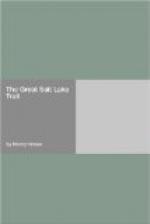Its peculiarity was its unusual size; in circumference it was as large as a man’s body. The general asked the Indians how they knew it was the thigh-bone of a man. They replied that a great many years ago, living on the plains, there was a race of men who were so big that it was said they were tall enough to run alongside of a buffalo, pick him up, put him under one of their arms, and tear off a whole quarter of his meat and eat it as they walked on. These large men became so powerful in their own estimation that they defied the Great Spirit. This angered the Great Spirit, and he made the rain come. It kept on raining until the rivers and creeks were full of water and flooded over their banks. The Indians were compelled to move out of the valleys and go up on the divides and small hills; but they were not allowed to remain there long. The water kept rising and rising until it covered the divides and little hills; so the Indians kept moving up, higher and higher, until they reached the top peaks of the Rocky Mountains, but the water still rose until it covered the highest points, and all these big people were drowned. After they were all dead, it ceased raining; the water began to recede, and finally returned to the original channels of the rivers and creeks. Then the Great Spirit made a race of people of the size that we are to-day; people whom he could handle and who would not defy him.
The word “medicine” in all of the tribes in some sense is a misnomer;[49] it really signifies dreamer, or prophet, and is synonymous with the word “prophet” in the Old Testament. The Indian form of government may be characterized as a theocracy, and the medicine-man is the high priest. His dreams and his prophecies are held sacred by the people. Should what he tells them turn out to be untrue, the fault lies with themselves, and he claims that his instructions have been disregarded. If by accident his dreams are exactly verified, the confidence of the tribe in their medicine-man surpasses all belief. The medicine lodge is their tabernacle of the wilderness—the habitation of the Great Spirit, the sacred ark of their faith.
The tribe of Indians known as the Crows[50] are entitled to the very marked distinction of being the most manly in their conduct in its relation to the whites. The integrity of their friendship has been tested on many occasions, and they have never proved false to their protestations. Their chiefs declare that a Crow was never known to kill a white man excepting in self-defence.
As has been the fate of the North American savage since that dark December day when the Pilgrims landed on Plymouth Rock, the Crows have been driven year after year from one of the most beautiful natural regions on the continent. Not only have the whites been the usurpers, but both the Sioux and the Cheyennes have been instrumental in confining them to a constantly decreasing area, until now the remnant of a once great nation is the ward of the government, and located on a limited reservation.




